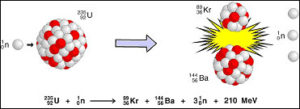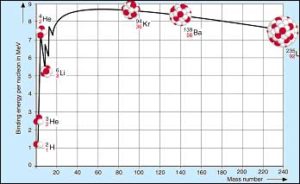FissionSee 'nuclear fission'. of an atomic nucleusPositively charged nucleus of an atom. Its diameter amounts ... into two parts of the same size caused by the collision of a particle. Nuclear fissionSee 'nuclear fission'. may also occur spontaneously in the case of very heavy nuclei; (See ‘fissionSee 'nuclear fission'., spontaneous’). The capture of a neutronUncharged elementary particle with a mass of 1.67492716 ·10... induces fissionSee 'nuclear fission'. of the nucleusPositively charged nucleus of an atom. Its diameter amounts ... of uranium-235. During the fissionSee 'nuclear fission'., in general two – more rarely three – fission productsNuclides generated by fission or subsequent radioactive deca..., two to three neutrons and energyAbility to do work or diffuse heat. The unit of energy is th... are generated.

Example for nuclear fissionSee 'nuclear fission'. of U-235
In the uraniumNatural radioactive element with the atomic number 92. The n... nucleusPositively charged nucleus of an atom. Its diameter amounts ... the nucleons are bound with an average energyAbility to do work or diffuse heat. The unit of energy is th... of about 7.6 MeVMegaelectron volt, 1,000,000 eV. per nucleonGroup name for protons and neutrons.. In the fissionSee 'nuclear fission'. product nuclei, the medium binding energyThe energy required to separate particles which are bound by... per nucleonGroup name for protons and neutrons. amounts to approx. 8.5 MeVMegaelectron volt, 1,000,000 eV.. This difference in binding energyThe energy required to separate particles which are bound by... of 0.9 MeVMegaelectron volt, 1,000,000 eV. per nucleonGroup name for protons and neutrons. is released in the nuclear fissionSee 'nuclear fission'.. Since the uraniumNatural radioactive element with the atomic number 92. The n... nucleusPositively charged nucleus of an atom. Its diameter amounts ... has 235 nucleons, a quantity of energyAbility to do work or diffuse heat. The unit of energy is th... of about 210 MeVMegaelectron volt, 1,000,000 eV. is released per fissionSee 'nuclear fission'.. It is made up of the following partial amounts:
- kinetic energyAbility to do work or diffuse heat. The unit of energy is th... of fission productsNuclides generated by fission or subsequent radioactive deca... 175 MeVMegaelectron volt, 1,000,000 eV.,
- kinetic energyAbility to do work or diffuse heat. The unit of energy is th... of fissionSee 'nuclear fission'. neutrons 5 MeVMegaelectron volt, 1,000,000 eV.,
- energyAbility to do work or diffuse heat. The unit of energy is th... of the gamma radiationHighly-energetic, short-wave electromagnetic radiation emitt... occurring during the fissionSee 'nuclear fission'. 7 MeVMegaelectron volt, 1,000,000 eV.,
- energyAbility to do work or diffuse heat. The unit of energy is th... of beta and gamma radiationHighly-energetic, short-wave electromagnetic radiation emitt... during the decayThe spontaneous conversion of a nuclide into another nuclide... of the radioactive fission productsNuclides generated by fission or subsequent radioactive deca... 13 MeVMegaelectron volt, 1,000,000 eV.,
- energyAbility to do work or diffuse heat. The unit of energy is th... of the neutrinos 10 MeVMegaelectron volt, 1,000,000 eV..

Course of nuclear binding energyThe energy required to separate particles which are bound by...
Due to the neutrons released during the nuclear fissionSee 'nuclear fission'. a chain reactionSelf-perpetuating reaction. In a fission chain reaction, a f... is possible in principle. Facilities where fissionSee 'nuclear fission'. chain reactions are initiated in a controlled manner are called nuclear reactors.
